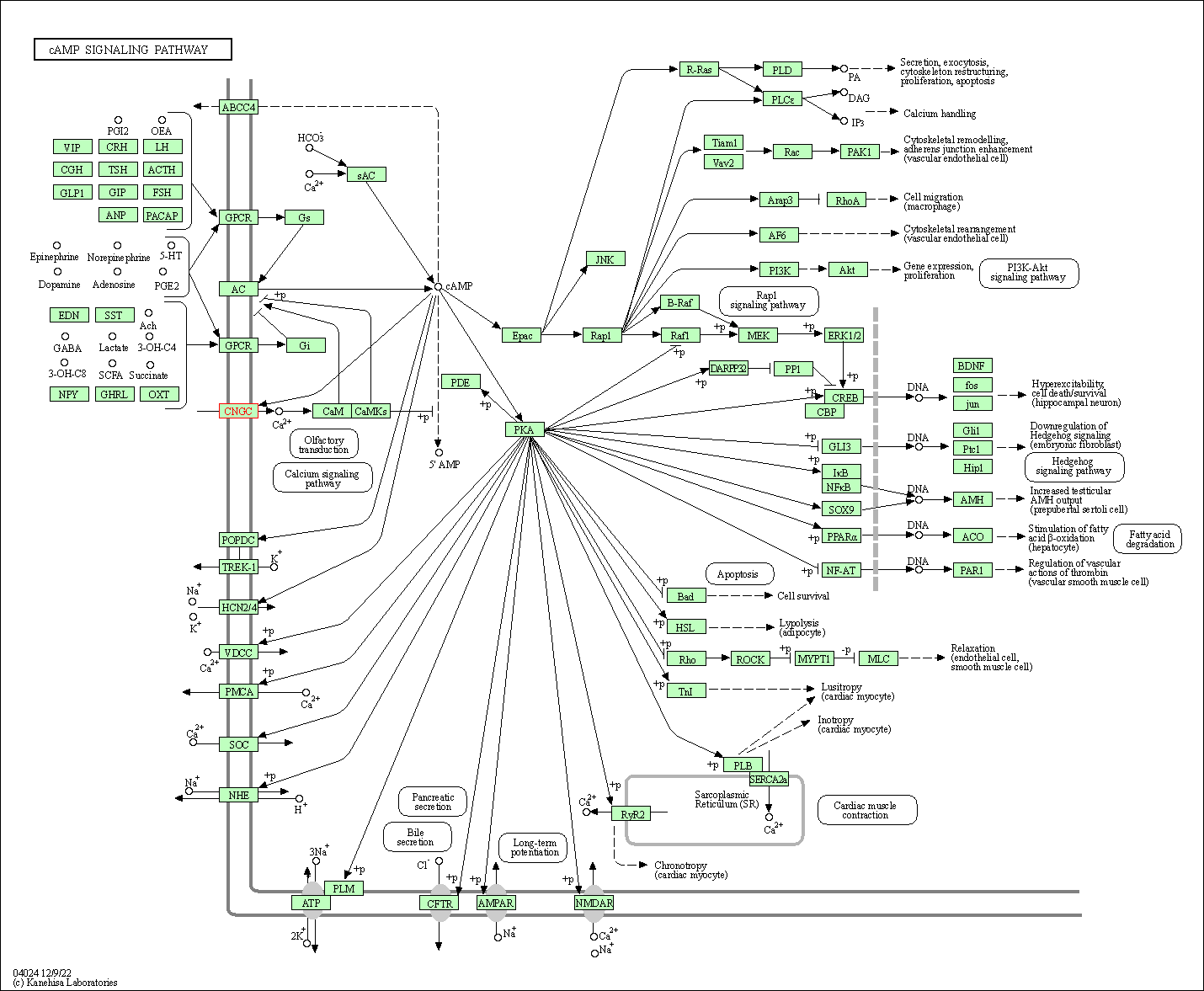Target Information
| Target General Information | Top | |||||
|---|---|---|---|---|---|---|
| Target ID |
T32227
(Former ID: TTDI02530)
|
|||||
| Target Name |
Cyclic nucleotide-gated channel beta-3 (CNGB3)
|
|||||
| Synonyms |
Cyclic nucleotidegated channel beta3; Cyclic nucleotidegated cation channel modulatory subunit; Cyclic nucleotidegated cation channel beta3; Cyclic nucleotide-gated cation channel modulatory subunit; Cyclic nucleotide-gated cation channel beta-3; Cone photoreceptor cGMPgated channel subunit beta; Cone photoreceptor cGMP-gated channel subunit beta; CNG channel beta3; CNG channel beta-3
Click to Show/Hide
|
|||||
| Gene Name |
CNGB3
|
|||||
| Target Type |
Clinical trial target
|
[1] | ||||
| Disease | [+] 1 Target-related Diseases | + | ||||
| 1 | Inherited retinal dystrophy [ICD-11: 9B70] | |||||
| Function |
Visual signal transduction is mediated by a G-protein coupled cascade using cGMP as second messenger. This protein can be activated by cGMP which leads to an opening of the cation channel and thereby causing a depolarization of rod photoreceptors. Induced a flickering channel gating, weakened the outward rectification in the presence of extracellular calcium, increased sensitivity for L-cis diltiazem and enhanced the cAMP efficiency of the channel when coexpressed with CNGA3 (By similarity). Essential for the generation of light-evoked electrical responses in the red-, green- and blue sensitive cones.
Click to Show/Hide
|
|||||
| UniProt ID | ||||||
| Sequence |
MFKSLTKVNKVKPIGENNENEQSSRRNEEGSHPSNQSQQTTAQEENKGEEKSLKTKSTPV
TSEEPHTNIQDKLSKKNSSGDLTTNPDPQNAAEPTGTVPEQKEMDPGKEGPNSPQNKPPA APVINEYADAQLHNLVKRMRQRTALYKKKLVEGDLSSPEASPQTAKPTAVPPVKESDDKP TEHYYRLLWFKVKKMPLTEYLKRIKLPNSIDSYTDRLYLLWLLLVTLAYNWNCCFIPLRL VFPYQTADNIHYWLIADIICDIIYLYDMLFIQPRLQFVRGGDIIVDSNELRKHYRTSTKF QLDVASIIPFDICYLFFGFNPMFRANRMLKYTSFFEFNHHLESIMDKAYIYRVIRTTGYL LFILHINACVYYWASNYEGIGTTRWVYDGEGNEYLRCYYWAVRTLITIGGLPEPQTLFEI VFQLLNFFSGVFVFSSLIGQMRDVIGAATANQNYFRACMDDTIAYMNNYSIPKLVQKRVR TWYEYTWDSQRMLDESDLLKTLPTTVQLALAIDVNFSIISKVDLFKGCDTQMIYDMLLRL KSVLYLPGDFVCKKGEIGKEMYIIKHGEVQVLGGPDGTKVLVTLKAGSVFGEISLLAAGG GNRRTANVVAHGFANLLTLDKKTLQEILVHYPDSERILMKKARVLLKQKAKTAEATPPRK DLALLFPPKEETPKLFKTLLGGTGKASLARLLKLKREQAAQKKENSEGGEEEGKENEDKQ KENEDKQKENEDKGKENEDKDKGREPEEKPLDRPECTASPIAVEEEPHSVRRTVLPRGTS RQSLIISMAPSAEGGEEVLTIEVKEKAKQ Click to Show/Hide
|
|||||
| 3D Structure | Click to Show 3D Structure of This Target | AlphaFold | ||||
| Drugs and Modes of Action | Top | |||||
|---|---|---|---|---|---|---|
| Clinical Trial Drug(s) | [+] 2 Clinical Trial Drugs | + | ||||
| 1 | AAV-CNGB3 | Drug Info | Phase 1/2 | Achromatopsia | [2] | |
| 2 | ACHM-CNGB3 | Drug Info | Phase 1/2 | Achromatopsia | [3] | |
| Mode of Action | [+] 1 Modes of Action | + | ||||
| Blocker (channel blocker) | [+] 1 Blocker (channel blocker) drugs | + | ||||
| 1 | L-(cis)-diltiazem | Drug Info | [1] | |||
| Cell-based Target Expression Variations | Top | |||||
|---|---|---|---|---|---|---|
| Cell-based Target Expression Variations | ||||||
| Different Human System Profiles of Target | Top |
|---|---|
|
Human Similarity Proteins
of target is determined by comparing the sequence similarity of all human proteins with the target based on BLAST. The similarity proteins for a target are defined as the proteins with E-value < 0.005 and outside the protein families of the target.
A target that has fewer human similarity proteins outside its family is commonly regarded to possess a greater capacity to avoid undesired interactions and thus increase the possibility of finding successful drugs
(Brief Bioinform, 21: 649-662, 2020).
Human Pathway Affiliation
of target is determined by the life-essential pathways provided on KEGG database. The target-affiliated pathways were defined based on the following two criteria (a) the pathways of the studied target should be life-essential for both healthy individuals and patients, and (b) the studied target should occupy an upstream position in the pathways and therefore had the ability to regulate biological function.
Targets involved in a fewer pathways have greater likelihood to be successfully developed, while those associated with more human pathways increase the chance of undesirable interferences with other human processes
(Pharmacol Rev, 58: 259-279, 2006).
Biological Network Descriptors
of target is determined based on a human protein-protein interactions (PPI) network consisting of 9,309 proteins and 52,713 PPIs, which were with a high confidence score of ≥ 0.95 collected from STRING database.
The network properties of targets based on protein-protein interactions (PPIs) have been widely adopted for the assessment of target’s druggability. Proteins with high node degree tend to have a high impact on network function through multiple interactions, while proteins with high betweenness centrality are regarded to be central for communication in interaction networks and regulate the flow of signaling information
(Front Pharmacol, 9, 1245, 2018;
Curr Opin Struct Biol. 44:134-142, 2017).
Human Similarity Proteins
Human Pathway Affiliation
Biological Network Descriptors
|
|
| Protein Name | Pfam ID | Percentage of Identity (%) | E value |
|---|---|---|---|
| Potassium voltage-gated channel subfamily H member 4 (KCNH4) | 19.383 (88/454) | 2.77E-17 |
| KEGG Pathway | Pathway ID | Affiliated Target | Pathway Map |
|---|---|---|---|
| cAMP signaling pathway | hsa04024 | Affiliated Target |

|
| Class: Environmental Information Processing => Signal transduction | Pathway Hierarchy | ||
| Degree | 4 | Degree centrality | 4.30E-04 | Betweenness centrality | 0.00E+00 |
|---|---|---|---|---|---|
| Closeness centrality | 1.60E-01 | Radiality | 1.24E+01 | Clustering coefficient | 1.00E+00 |
| Neighborhood connectivity | 6.50E+00 | Topological coefficient | 5.42E-01 | Eccentricity | 14 |
| Download | Click to Download the Full PPI Network of This Target | ||||
| Target Affiliated Biological Pathways | Top | |||||
|---|---|---|---|---|---|---|
| KEGG Pathway | [+] 1 KEGG Pathways | + | ||||
| 1 | cAMP signaling pathway | |||||
| Panther Pathway | [+] 1 Panther Pathways | + | ||||
| 1 | Heterotrimeric G-protein signaling pathway-rod outer segment phototransduction | |||||
| PID Pathway | [+] 1 PID Pathways | + | ||||
| 1 | Visual signal transduction: Cones | |||||
| References | Top | |||||
|---|---|---|---|---|---|---|
| REF 1 | Molecular cloning and functional characterization of a new modulatory cyclic nucleotide-gated channel subunit from mouse retina. J Neurosci. 2000 Feb 15;20(4):1324-32. | |||||
| REF 2 | Clinical pipeline report, company report or official report of MeiraGTx. | |||||
| REF 3 | Clinical pipeline report, company report or official report of Applied Genetic Technologies. | |||||
If You Find Any Error in Data or Bug in Web Service, Please Kindly Report It to Dr. Zhou and Dr. Zhang.

